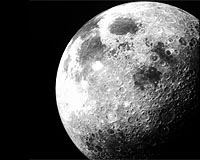 |
Science@NASA Huntsville AL (SPX) Nov 16, 2009 The argument that the Moon is a dry, desolate place no longer holds water. Researchers have revealed preliminary data from NASA's Lunar Crater Observation and Sensing Satellite, or LCROSS, indicating that water exists in a permanently shadowed lunar crater. The discovery opens a new chapter in our understanding of the Moon. "We are ecstatic," said Anthony Colaprete, LCROSS project scientist and principal investigator at NASA's Ames Research Center in Moffett Field, Calif. The LCROSS spacecraft and a companion rocket stage made twin impacts in crater Cabeus near the Moon's south pole on Oct. 9th. A plume of debris traveled at a high angle beyond the rim of Cabeus and into sunlight, while an additional curtain of debris was ejected more laterally. "Multiple lines of evidence show water was present in both the high angle vapor plume and the ejecta curtain created by the LCROSS Centaur impact," says Colaprete. "The concentration and distribution of water and other substances requires further analysis, but it is safe to say Cabeus holds water." Since the impacts, the LCROSS science team has been analyzing the huge amount of data the spacecraft collected. The team concentrated on data from the satellite's spectrometers, which provide the most definitive information about the presence of water. A spectrometer helps identify the composition of materials by examining light they emit or absorb. The team took the known near-infrared spectral signatures of water and other materials and compared them to the impact spectra the LCROSS near infrared spectrometer collected. "We were able to match the spectra from LCROSS data only when we inserted the spectra for water," Colaprete said. "No other reasonable combination of other compounds that we tried matched the observations. The possibility of contamination from the Centaur also was ruled out." Additional confirmation came from an emission in the ultraviolet spectrum that was attributed to hydroxyl (OH), one product from the break-up of water by sunlight. Data from the other LCROSS instruments are being analyzed for additional clues about the state and distribution of the material at the impact site. The LCROSS science team and colleagues are poring over the data to understand the entire impact event, from flash to crater. The goal is to understand the distribution of all materials within the soil at the impact site. "The full understanding of the LCROSS data may take some time. The data is that rich," Colaprete said. "Along with the water in Cabeus, there are hints of other intriguing substances. The permanently shadowed regions of the Moon are truly cold traps, collecting and preserving material over billions of years." Stay tuned for updates. Share This Article With Planet Earth
Related Links LCROSS Science@NASA Mars News and Information at MarsDaily.com Lunar Dreams and more
 Moon holds key to solar system's secrets
Moon holds key to solar system's secretsWashington (AFP) Nov 13, 2009 The moon, which is once again the focus of an international space race, could hold the key to the birth of our planet some 4.5 billion years ago, and help unlock the oldest secrets of the universe. Forty years after American Neil Armstrong first walked on the moon, and as the United States aims to return astronauts to Earth's nearest neighbor by 2020, it remains an object of fascination and ... read more |
|
| The content herein, unless otherwise known to be public domain, are Copyright 1995-2009 - SpaceDaily. AFP and UPI Wire Stories are copyright Agence France-Presse and United Press International. ESA Portal Reports are copyright European Space Agency. All NASA sourced material is public domain. Additional copyrights may apply in whole or part to other bona fide parties. Advertising does not imply endorsement,agreement or approval of any opinions, statements or information provided by SpaceDaily on any Web page published or hosted by SpaceDaily. Privacy Statement |